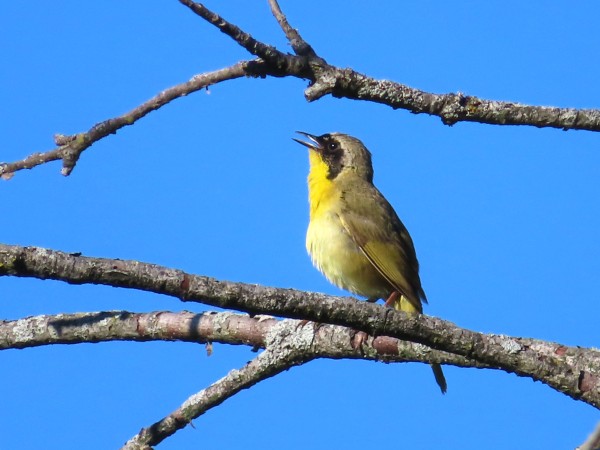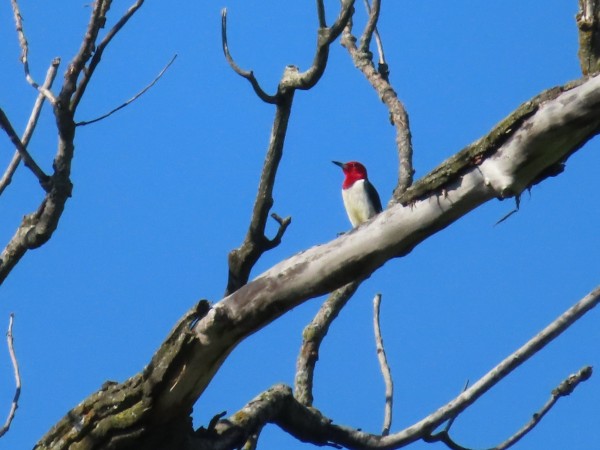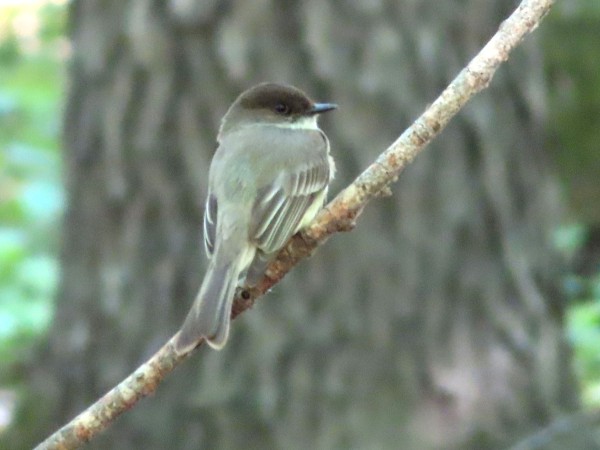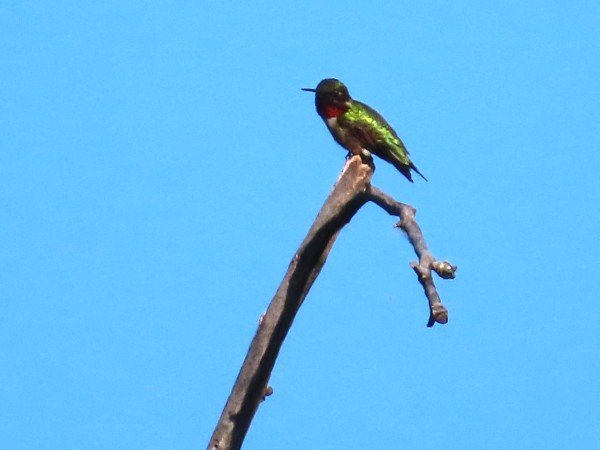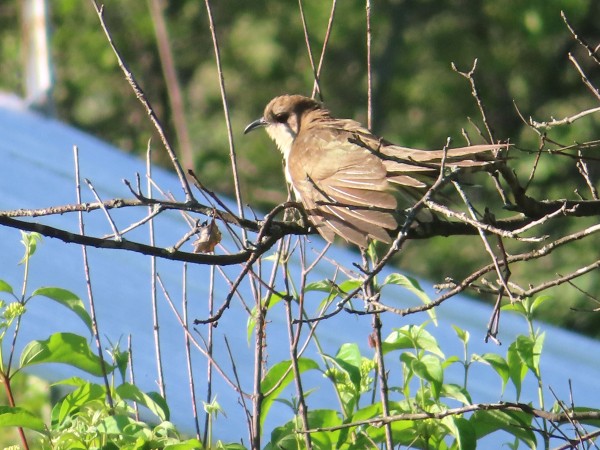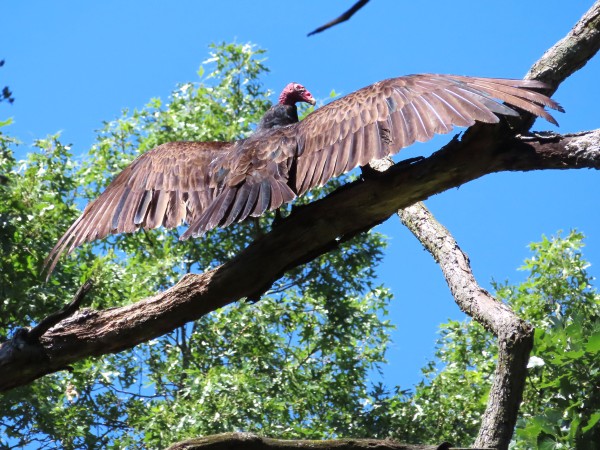Chuck's Birding Report #119
21 June - 27 June 2022
Dear fellow flock of birders,
The birds were active this past week but mostly what you would expect this time of year.
I’m seeing more and more parents feeding fledglings. I saw one Tree Swallow trying to feed four fledglings. The Tree Swallow fledglings were perched on a branch side by side. When a parent approached the fledglings fluttered their wings and opened their beaks to be fed. The parent while in flight stuffed a bit of food in the fledglings open mouths.
I saw one Common Grackle fledgling chasing its parent around at the top of a snag calling for food. While I watched, the fledgling got nothing. I’m sure the fledgling got some food later in the day. Down by Pond 2 a Willow Flycatcher parent was being followed by a fledgling. The parent did find some insects to feed to the fledgling.
Along the path from Teal Pond to Pond 2 I came across a Song Sparrow with an insect in its beak. Since it was in a small leafless tree close to me it was scolding me. It’s amazing how much birds vocalize with beaks full of food. I then found the fledgling about three feet below the parent. I came across an American Robin with a beak full of earthworms. It was really scolding me. As I walked away far enough I saw the robin take the worms to a nest full of nestlings not fledglings.
I saw one fledgling that I could not identify. Its colors were light yellow and white. I had no clue until the parent came to feed it. The parent was a Yellow Warbler. So that’s what the fledgling of a Yellow Warbler looks like. Fledglings can be hard to identify sometimes.
The Yellow Warblers and Common Yellowthroats are mainly seen on Curtis Prairie. They nest in some of the small shrubs. They seem to be singing all the time. My bird app called Merlin is constantly showing both warblers as it responds to these warblers’ vocalizations. Included are photos of a male Yellow Warbler and a male Common Yellowthroat. They are handsome fellows.
I had two different birding experiences on Saturday and Sunday. On Saturday as I left the house it was not raining but it was overcast. Immediately as I parked my car in the Visitor Center parking lot at the Arb it started to rain. I don’t mind birding in the rain when it comes down gently but it was coming down hard. I sat in my car trying to decide what to do. I finally came up with birding under a big umbrella. The birding was okay except it takes five hands to accomplish it. One to hold the umbrella, one to hold my binoculars, one to manipulate my cell phone while I played the Merlin sound ID, one to write my bird entries in my tiny notebook and finally one to whip my hanky back and forth to discourage the mosquitoes who joined me under the umbrella from taking too many pints of blood. Surprisingly I was the only birder I saw that morning. The only other people I saw Saturday were some scantily clad runners who were enjoying a great run and a shower too. I didn’t stay long. Oh, and I didn’t see many birds.
Sunday on the other hand was just the opposite of Saturday. The sun was out, it was cool and there was a gentle breeze. The birds were all over the place and singing joyfully. I stayed out for 4 hours having the time of my life. My best find was first hearing and then seeing a pair of Red-headed Woodpeckers. I was standing on the path going from Teal Pond to Pond 2 and looking west. There are some large snags on the west side of Teal Pond Marsh. In one of the snags I could see the Red-headed Woodpeckers flying around various parts of one snag. They found a hole that they were really interested in. I saw one of the Red-headed Woodpeckers go in the hole and then stick its head out. A single Red-headed Woodpecker has been seen in this area off and on for a couple weeks. This is the first time I’ve seen two. We are all hoping that it is a pair and that they will build a nest and raise young there. To be continued. Included are two photos of the Red-headed Woodpeckers. One is of the woodpecker sticking its head out of the hole in the snag while the other shows one that flew closer to me so I could get a bit better photo.
Also on Sunday I walked in the woods without any bothersome insects, hurray! I found an Eastern Phoebe, which seemed relatively scarce this year, perched on a low branch just north of a stone building whose address on the door, 2802 Gallistel, I had never noticed before. Do you know where that is? Included is a photo of the Eastern Phoebe.
On many of my walks in the Arb I often see Ruby-throated Hummingbirds perched at the top of small snags surveying their territory. They are always males but the throats are black not red. The feathers in the throat must be oriented just right to be able to reflect the ruby red color. Once in a great while I see a little of the red on the hummingbird. Included is a photo of a Ruby-throated Hummingbird with a bit of red showing.
Last Thursday as I walked south of the pump house I saw a good-sized bird fly low over East Curtis Prairie. I didn’t know what it was at first. I did get my binoculars on it and I identified it as a Black-billed Cuckoo. It had a relatively large, down-curved beak. Both the upper and lower parts of the beak were black. It also had a red ring around the eye. It kept flying low over the prairie and kept landing in some of the small shrubs. It would occasionally land on the ground too. On the last ground landing it never came up again. In reading about its nesting habits I learned that they nest in low bushes and sometimes even on the ground. I’m wondering if this might be nesting on East Curtis Prairie. It’s possible. Included is a photo of the Black-billed Cuckoo.
Last Thursday I also took a walk in the Grady Tract. While there I saw a Turkey Vulture soaring not very high in the sky. But then it came close to the top of the trees and landed on a bare branch. It immediately spread its wings out fully to the sides of its body. I’m not sure why it spread out its wings but maybe it was a way of cooling its body. I was also able to see its somewhat bizarre looking head. It is featherless and red in color. It has very large nostrils. Included is a photo of the Turkey Vulture.
For my last photo I chose a Gray Catbird. They are often one of the first birds I see and hear when I arrive at the Arb in the morning. They have a lot to say so they chatter a lot. Every so often they let out a meow that sounds like a cat’s meow. So the name Catbird fits well with its given name. The Gray Catbirds do well reproductively in the Arb. Included is a photo of a vocalizing Gray Catbird.
Again I encourage you to not only enjoy the birds in the Arb but also look closely at and learn all the other wonders of nature such as all the wildflowers, the butterflies, the dragonflies, the beetles, the bumble bees, the turtles and all the little half-inched toads especially numerous on the trail between Teal Pond and Pond 2. In the bird world we have nestlings and fledglings. I think these little toads should be called toadlings.
That’s the Arboretum bird report for the past week.
I wish all of you good health and good birding too,
Chuck


